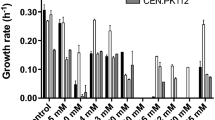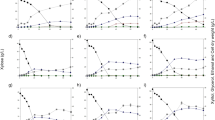Abstract
The use of lignocellulosic residues for ethanol production is limited by toxic compounds in fermenting yeasts present in diluted acid hydrolysates like acetic acid and 2-furaldehyde. The respiratory deficient phenotype gives the cell the ability to resist several toxic compounds. So the aim of this work was to evaluate the tolerance to toxic compounds present in lignocellulosic hydrolysates like acetic acid and 2-furaldehyde in Pichia stipitis and its respiratory deficient strains. The respiratory deficient phenotype was induced by exposure to chemical agents such as acriflavine, acrylamide and rhodamine; 23 strains were obtained. The selection criterion was based on increasing specific ethanol yield (g ethanol g−1 biomass) with acetic acid and furaldehyde tolerance. The screening showed that P. stipitis NRRL Y-7124 ACL 2-1RD (lacking cytochrome c), obtained using acrylamide, presented the highest specific ethanol production rate (1.82 g g−1 h−1). Meanwhile, the ACF8-3RD strain showed the highest acetic acid tolerance (7.80 g L−1) and the RHO2-3RD strain was able to tolerate up to 1.5 g L−1 2-furaldehyde with a growth and ethanol production inhibition of 23 and 22 %, respectively. The use of respiratory deficient yeast phenotype is a strategy for ethanol production improvement in a medium with toxic compounds such as hydrolysed sugarcane bagasse amongst others.


Similar content being viewed by others
Abbreviations
- Y x /s :
-
Biomass yield (g biomass g−1 substrate)
- Yet/s :
-
Ethanol yield (g ethanol g−1 substrate)
- Yet/x :
-
Specific etanol yield (g ethanol g−1 biomass)
- V p :
-
Ethanol specific production rate (g ethanol g−1 biomass h−1)
- X :
-
Biomass production (g L−1)
- X 0 :
-
Biomass production without inhibitor (g L−1)
- k :
-
Acetic acid sensitivity
- t :
-
Time (h)
- P :
-
Acetic acid (g L−1)
- P c :
-
Acetic acid critic concentration (g L−1)
- n :
-
Exponential adjustment
- X e :
-
Biomass production with 2-furaldehyde (g L−1)
- P e :
-
Ethanol production with 2-furaldehyde (g L−1)
- P 0 :
-
Ethanol production without 2-furaldehyde (g L−1)
References
Chen XJ, Clark-Walker D (1998) Petite mutation on yeasts: 50 years on. In: Jeon Kwang W (ed) International review of cytology: a survey of cell biology, vol 194. Academic Press, USA
Bacila M, Horii J (1979) Improving the efficiency of alcohol with respiration-deficient yeast mutants. Trends Biochem Sci 4(3):59–61
Walker MG (1998) Yeast physiology and biotechnology. John Wiley & Sons, Chichester
Ortiz-Muñiz B, Aguilar-Uscanga B, Carvajal-Zarrabal O, Aguilar-Uscanga MG (2012) Improvement in ethanol production using respiratory deficient phenotype of a wild type yeast Saccharomyces cerevisiae ITV-01. Renew Energy 37:197–201
Allen S, Clark W, McCaffery JM, Cai Z, Lanctot A, Slininger PJ, Liu ZL, Gorsich SW (2010) Furfural induces reactive oxygen species accumulation and cellular damage in Saccharomyces cerevisiae. Biotechnol Biofuels 3:2
Palmqvist E, Hahn-Hagerdal B (2000) Fermentation of lignocellulosic hydrolysates II: inhibitors and mechanisms of inhibition. Bioresour Technol 74:25–33
Powchinda O, Delia-Dupuy ML, Strehaiano P (1995) Effects of acetic acid growth and fermentative activity of Saccharomyces cerevisiae. Biotechnol Lett 17–2:237–242
Pampulha ME, Loureiro V (1989) Interaction of effects of acetic acid and ethanol inhibition of fermentation in Saccharomyces cerevisiae. Biotechnol Lett 11(4):269–274
Chmielewska J, Dziuba E (2003) Respiratory deficient mutants of xylose-fermenting yeast––obtainment and features. EJPUA 6(2):01
Ooi BG, Lankford KR (2009) Strategy for adapting wine yeasts for bioethanol production. Int J Mol Sci 10:385–394
Nagai S (1963) Diagnostic color differentiation plates for hereditary respiration deficiency in yeast. J Bacteriol 86:299–302
Ortiz-Muñiz B, Carvajal-Zarrabal O, Torrestiana-Sánchez B, Aguilar-Uscanga MG (2010) Kinetic study on ethanol production using S. cerevisiae ITV-01 yeast isolated from sugar cane molasses. J Chem Technol Biotechnol 85:1361–1367
Lange H, Bavouzet JM, Taillander P, Delorme C (1993) Systematic error and comparison of four methods for assessing the viability of Saccharomyces cerevisiae suspensions. Biotechnol Tech 7:223–228
Claisse MI, Genenieve A, Pere-Aubert A, Clavilier LP, Slonimski PP (1970) Méthode d’estimation de la concentration des cytochromes dans les cellules entières de levure. Eur J Biochem 16:430–438
Guiraud JP, Bourgi J, Stervinou M, Claisse M, Galzy P (1987) Isolation of a respiratory deficient Kluyveromyces fragilis mutant for the production of ethanol from Jerusalem artichoke. Biotechnol Bioeng 29:850–858
Hutter A, Oliver SG (1998) Ethanol production using nuclear petite yeast mutants. Appl Microbiol Biotechnol 49:511–516
Aguilar MG (1998) Caractérisation cinétique et metabolique d’une souche de Brettanomyces. These Dr és Sciences I N P Toulouse, France
Ortiz-Muñiz B (2010) Estudio de la fisiología de S. cerevisiae ITV-01 y su deficiente respiratoria para la producción de etanol. PhD Thesis, Veracruz Institute of Technology, Mexico
Acknowledgments
Authors acknowledged the economical support from the National Council of Science and Technology, Mexico (CONACYT project #128052) and the critical reading of Patricia Hayward Jones MSc. and Dulce María Barradas Dermitz MSc.
Author information
Authors and Affiliations
Corresponding author
Rights and permissions
About this article
Cite this article
Ortiz-Muñiz, B., Rasgado-Mellado, J., Solis-Pacheco, J. et al. Evaluation of the tolerance of acetic acid and 2-furaldehyde on the growth of Pichia stipitis and its respiratory deficient. Bioprocess Biosyst Eng 37, 2061–2066 (2014). https://doi.org/10.1007/s00449-014-1183-8
Received:
Accepted:
Published:
Issue Date:
DOI: https://doi.org/10.1007/s00449-014-1183-8




